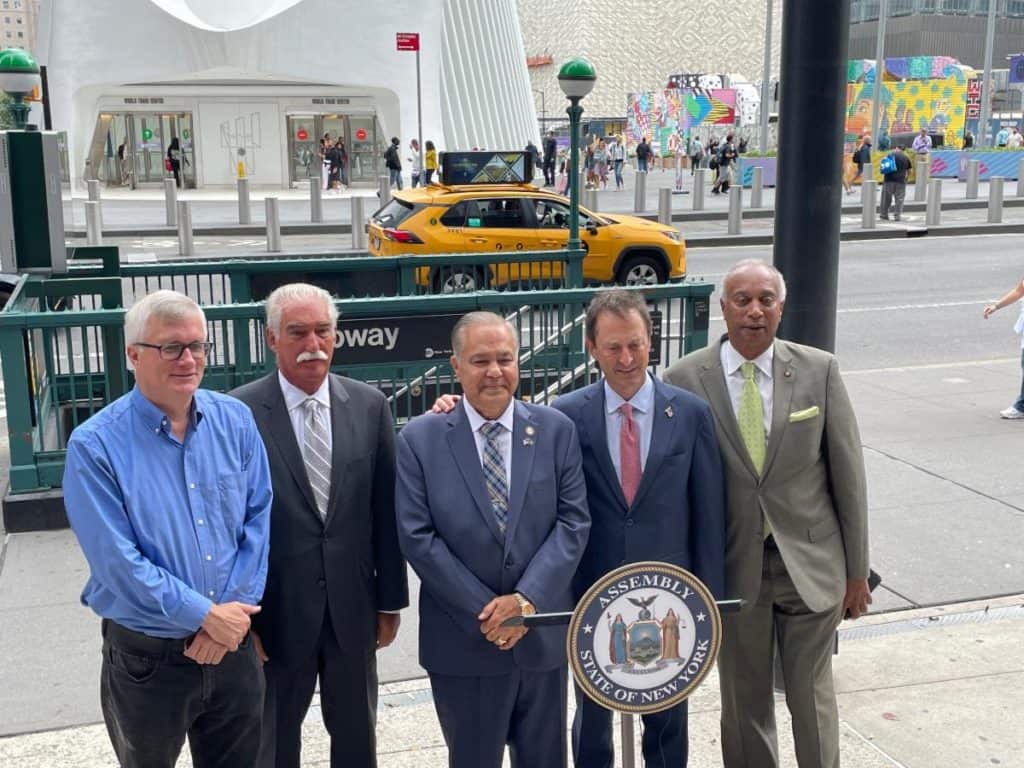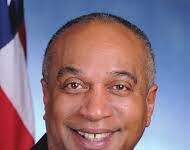
Thousands of civilian employees, including construction workers involved in the massive cleanup of Ground Zero 21 years ago, are eligible for World Trade Center victims’ health coverage but have not registered for essential benefits. Today, New York State Assemblyman Nader Sayegh, Assemblyman J. Gary Pretlow and State Senator Brian P. Kavanagh joined 9/11 legal advocate Michael Barasch and construction industry leadership to call for public hearings and passage of legislation requiring employers to make their employees aware of their eligibility.
While most uniformed emergency responders have enrolled in the World Trade Center Health Program, it is estimated that only 10 percent of other workers and citizens who would qualify for the coverage have enrolled.
New legislation introduced by Assemblyman Sayegh this session, the “9/11 Notice Act” (A-9715), would require businesses with 50 or more employees that were in operation between September 2001 and May 2002,and within the Lower Manhattan exposure zone, to inform their current and former employees, of their right to register under the James Zadroga 9/11 Health and Compensation Reauthorization Act, which reauthorized the WTC Health Program for 75 years, ending in 2090.
This year marks the 21 st anniversary of the 9/11 terrorist attack at the World Trade Center. After the collapse of the Twin Towers, an estimated 1.2 million tons of debris, soot, and toxic ash laced with cancer causing carcinogens blanketed lower Manhattan and parts of Brooklyn.
The U.S. Department of Environmental Protection Agency told New Yorkers that the air was safe to breathe and encouraged more than 400,000 people in lower Manhattan to return to work, school and their homes; however, it was not safe. In fact, the air was proven to be deadly and linked to more than 4,610 deaths by 9/11 related illnesses some 20 years later—an ever-growing number that exceeds the 2,966 people who died on the day of the attacks.
Assemblyman Nader Sayegh (D-Yonkers, 90 th AD) who sponsored the 9/11 Notice Act, said: “Not all of our 9/11 heroes wore uniforms. Those who came back to their jobs south of Canal Street and got New York’s economy moving again are also heroes, and they breathed the same toxic air as our first responders.”
He continued, “With the 9/11 Notice Act, we can notify these New Yorkers of their right to healthcare under the World Trade Center Health Program and make sure those facing the prospect of a 9/11 related illness get access to healthcare and avoid costly deductibles. Medical expenses, especially for cancer and respiratory ailments, can be extremely expensive. Patients are often left with huge bills they cannot afford,averaging $42,000 in the year following a cancer diagnosis. The new legislation is designed to locate lost
9/11 victims, as much as 400,000 people, to let them know they have a lifeline and do not have to drown in debt while gaining access to life-saving treatments on the road to recovery.”
9/11 Legal Advocate Michael Barasch, managing partner of Barasch & McGarry, which has helped more than 25,000 members of the 9/11 community qualify, including more than 10,000 FDNY and NYPD members said: “More people have died of 9/11-related illnesses than from the attacks themselves.
Anyone who was regularly in the area during this time is eligible to sign up for the World Trade Center Health Program (WTCHP) to receive free health care for life through the Victims’ Compensation Fund. More than 115,000 people have signed up so far, but there are hundreds of thousands of eligible New Yorkers who have yet to do so.”
Assemblyman J. Gary Pretlow (D-Mount Vernon, 89 thAD) said: “I will never forget the smell of burning metal and the sight of the chalky dust cloud that engulfed Lower Manhattan after the terrorist attack on 9/11. More than two decades later, the potent smell and powdery dust are gone; however, the effects of the toxins still linger, causing more than 4,600 deaths since 9/11—more than the death toll on that terrible day. Most people who returned to work or school in the area were exposed to serious health risks, but data shows that hundreds of thousands of them do not know the potential long-term dangers of 9/11 toxins. This new legislation represents a moral imperative to find forgotten 9/11 victims who are still at risk of sickness 20 years later and help them access health resources for life.”
Louis J. Coletti, president and CEO of the Building Trades Employers Association (BTEA), representing 1,2000 union construction contractors said: “There are estimates about 3,000 construction workers were involved in the cleanup of the World Trade Center after 9/11. Very few are aware that the health coverage provided to emergency responders is available for them as well. I urge anyone who worked here during the recovery to register. Cancer and other serious illnesses caused by toxins can take years to develop, and we should take every step necessary to notify people who are eligible for protection.”
State Senator Brian D. Kavanagh (D-lower Manhattan, west Brooklyn, 26 th District), who vowed to be a prime sponsor of the 911 Notice Act in the State Senate, said: “The funds do not help people if they are not aware that they can enroll. There is an opportunity here for them to get monitored and get the healthcare they need.”
Bronx resident Alice Vigo, an office worker employed by an insurance company near Ground Zero, recalled walking home “covered in dust” on 9/11 and said she is now recovering from lung cancer. “Half of my colleagues are either battling cancer or have already died. We have to get the word out there.”
The 9/11 Notice Act would require companies with 50 or more employees that were in Lower Manhattan (South of Canal Street) from 9/11/2001 thru 5/30/2002 or had employees working there to notify – via letter/email/text, etc – their employees, retirees, or former workers that they are eligible to register for the World Trade Center Health Program and how to go about it.
By enrolling in the WTC Health Program, all costs related to hospitalizations, treatments, and medications are fully covered. Cancer treatments could amount to thousands of dollars each month. The WTC Health Program also allows individuals to bypass union or company health plans to access these benefits granted to them by Congress, possibly making organizations eligible for reimbursement for certain past health coverage expenditures. There are also many companies, such as retailer Century 21 located across from the World Trade Center, that may have moved or gone out of business, making it even more difficult for former employees to document and prove eligibility.





